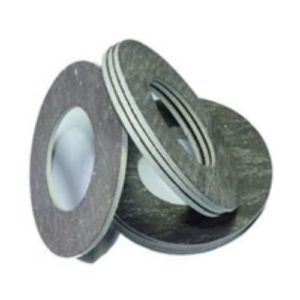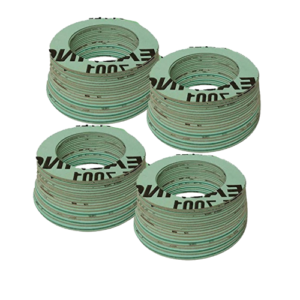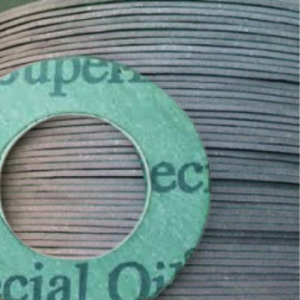Description
CAMPROFILE GASKETS
Camprofile gaskets consist of a metal core with deep grooves on either side with sealing materials (usually Stainless Steel). Graphite, PTFE (Teflon), CAF or Metal (e.g. Aluminum or Silver) may be the sealing layers (depending on the service duty). Camprofile’s can be used to provide an outstanding seal without binding layers, but there is a risk of damage to the flange surface.
The very wide seating stress range (minimum to maximum stress) of the camprofile gasket makes it
- Highly suitable for varying temperatures and pressures.
- Less senstive to assembly faults (inaccurate bolt tensioning).
- Suitable for light and heavily constructed flanges.
- Dependent on layer material camprofile gaskets are resistant to temperatures up to 1000 0C.
- Resistant to media pressures up to 250 bar.
The additional benefits are
- When assembled the layer thickness of the sealing material is extremely small (0.5mm) thus reducing leaks, reject rates and environment pollution.
- The gasket will not damage the flange surface and can be easily removed.
- Reduces maintenance costs.
- Emergency sealing of damaged flanges by using 1mm thick sealing layers until the flange can be reworked.
- Flange face protection Camprofiles wil not damage the flange faces even at extreme seating load.
- Excellent performance when subject to fluctuating temperatures and pressures.
- Direct replacement for existing gaskets. No special flange finish is necessary.
- Eco-friendly by significantly reducing leakage into the atmosphere.
Flange surface Finish
The recommended flange surface finish for camprofiles with sealing layers is from 125-250 RMS.
Loose or Integral rings
Thermal-shock conditions may damage camprofiles with integral centring rings (thermal tension may cause cracks in the core).

SEALING LAYER MATERIALS AND SEALING STRESSES
The following table gives information regarding different types of materials offered as sealing layer materials by IGP. Also given is recommended seating stress range for reliable and effective performance:
| Material | Temp (Deg.C) |
Max. Operating Pressure (Bar) |
Gas Tightness | Application | Seating Stress | |||
| Min | Max | Min (N/mm2) | Optimum (N/mm2) | Max (N/mm2) | ||||
| Graphite | -200 | 550 | 250 | Good | Aggressive Media |
20 | 90 | 400 |
| PTFE | -200 | 250 | 100 | Good | Aggressive Media |
20 | 90 | 400 |
| CAF | -150 | 450 | 100 | Moderate | Liquids | 65 | 161 | 400 |
| Silver | -200 | 750 | 250 | Good | Aggressive Media |
125 | 240 | 450 |
CORE THICKNESS
When a Camprofile is replacing an existing gasket (eg. spiral wound gasket); werecommends a 4mm thick core to prevent unnecessary stresses on existing pipe lines. For new system, we also recommend 5 mm thick cores. The value should be taken into account at the design stage.
| Pipe system | Core thicknes | Seated Thickness (Core + 2 sealing layers) |
| Existing | 4mm | 5.0mm to 5.2mm |
| New | 5mm | 6.0mm to 6.2mm |





